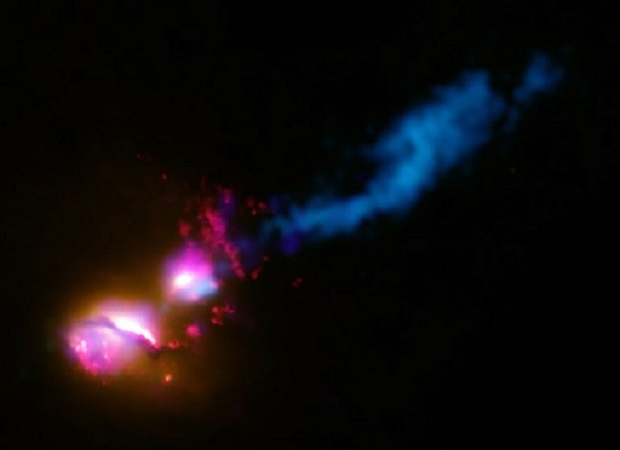Dormant black hole ‘awakens,’ devours star

This composite image obtained 17 December 2007 from NASA shows the jet from a black hole at the center of a galaxy striking the edge of another galaxy — the first time such an interaction has been found. The massive cosmic assault of a black hole blasting an immense jet of energy and radiation into a nearby galaxy has been observed by astronomers for the first time, NASA announced 17 December 2007. In a burst of galactic violence recorded by astronomers in the US space agency’s ground and space-based observatories, the black hole of a “death star” is seen shooting the jet of radiation into the adjacent galaxy, which glows as it deflects much of the energy, NASA said. In the image, data from several wavelengths have been combined. X-rays from Chandra (colored purple), optical and ultraviolet (UV) data from Hubble (red and orange), and radio emission from the Very Large Array (VLA) and MERLIN (blue) show how the jet from the main galaxy on the lower left is striking its companion galaxy to the upper right. The jet impacts the companion galaxy at its edge and is then disrupted and deflected, much like how a stream of water from a hose will splay out after hitting a wall at an angle. AFP / NASA
PARIS, France — Scientists reported Wednesday that they witnessed in unprecedented detail a star being ripped to shreds and devoured by a dormant supermassive black hole.
The celestial feeding frenzy — known as a tidal disruption event — was detected from the high-energy, X-ray echoes emitted as debris from the hapless star swirled in a vortex near the black hole’s center.
The findings were published in the prestigious science journal Nature.
“Never before have we been able to see strong gravity effects from a dormant black hole,” Erin Kara, a Hubble postdoctoral fellow at the University of Maryland, and lead author of the study, told AFP.
Black holes are regions in space-time where mass is collapsed into such a small area that gravity takes over completely, and nothing — not even light — can escape.
They cannot be seen, and are inferred from their influence on nearby objects.
Most of what astronomers know about so-called supermassive black holes — found at the center of galaxies — comes from a relative handful that actively gather and consume matter.
Roughly 90 percent are dormant, only awakening from time to time to gulp down anything that passes too close.
When that happens to a star, it disappears in a swirling flash of energy and light.
Slumbering giant
“Most tidal disruptions don’t emit much in the high-energy X-ray band,” Kara explained.
Only three such episodes have ever been recorded, “and this is the first such event that has been caught at its peak”.
The tell-tale signs from this particular slumbering giant, dubbed Swift J1644+57, were picked up by NASA’s Swift satellite, the researchers reported.
Three more satellites — one from the European Space Agency, another from Japan, and a third from NASA — tuned in to the event, yielding a treasure-trove of “excellent data”.
The fact that X-rays could be detected at all stems from the amplifying effect of the so-called accretion disk — the doughnut-like swirl of matter falling into the black hole.
Scientists had previously thought X-rays generated in the death throes of a disintegrating star came from huge beams of particles already ejected by the black hole.
The new observations tell another story: “Actually, we can see this reverberation at work very close to the central black hole,” Kara said.
Black holes that are dormant today played a key role in the evolution of galaxies, so seeing one in action may provide clues about the formation of the Universe, said co-author Chris Reynolds, a professor at the University of Maryland.
“If we only look at active black holes, we might be getting a strongly biased sample,” he said in a statement.
One of the crucial unanswered questions about black holes, for example, is how fast they rotate, or spin. Knowing this would yield valuable clues on how they form and mature.
One theory suggests that black holes become dormant after they reach “maximal spin”, in which case they should all be spinning at the same rate.
Another says black holes only grow by merging with each other, in which case spin rates would be more variable.